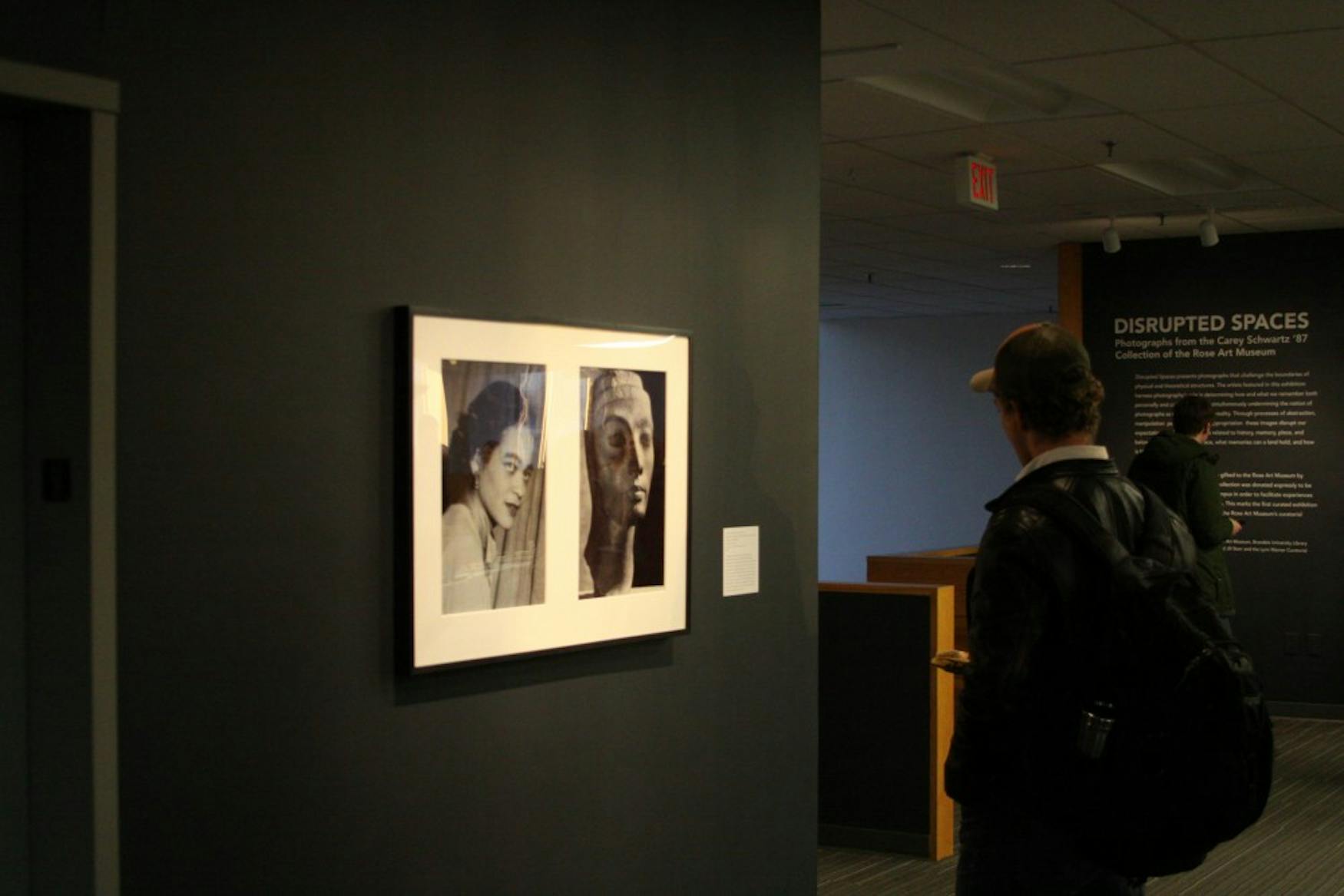Exhibit brings art to Farber Mezzanine
Students studying in the Farber Library Mezzanine might notice that as of Thursday some of the walls near the mezzanine’s entrance have drastically changed color. The space near Farber’s entrance now encapsulates floating heads, tidal waves and graffiti art between frames and glass panes hanging on the navy walls.
Farber’s newly navy walls and framed photographs are part of Disrupted Spaces, a photography exhibit highlighting five artists’ renditions of culturally, historically and personally significant spaces.
Organized by Rose curatorial interns Sofia Retta ’15 and Sarah McCarty ’15, the exhibit showcases pieces from the Carey Schwartz ’87 Collection of the Rose Art Museum.
The collection was intended for display outside of the museum with the aim of exposing students to art on their own time and in new settings. Part of the mezzanine’s renovation plans was to host collaborations with the museum, and Disrupted Spaces is one of the first of such collaborations between the Rose, the Fine Arts department and the library.
The exhibit’s five photographs hang on the walls bordering the mezzanine’s entrance. The exhibit, spanning the length of the room, faces outward toward the study spaces. The wall closest to the Starbucks holds a blurb that briefly details the theme and purpose of Disrupted Spaces. Aside from the change in wall colors and the added spotlights, the mezzanine’s appearance is unchanged and the exhibit is seemlessly integrated into the space.
On the rightmost side of the exhibit is a two-photograph black and white series. Each side holds artist Lorraine Grady’s photographing of a face—one face depicts the artist’s late family member and the other, Ancient Egyptian Queen Nefertiti. “Miscegenated Family Album (Progress of Queens), L: Devonia, age 36; R: Nefertiti, age 36” (1980/1994) draws a connection between the two women.
Miscegenation refers to mixing of different racial groups with the work’s accompanying plaque explaining that O’Grady “uses the term to emphasize notions of hybridity in both the form and content of her series.” Grady uses the series to insert her family into a larger narrative, combining the personal and the historical and playing off of her own African, Caribbean and Irish background.
On the far left of the exhibit near the Makerlab is an all-blue photograph of ambiguous scenery, including tiles, a sea and a light blue sky. The shades of blue in Orit Raff’s 2007 work “Untitled (Horizon)” are so similar that it is challenging to discern which shape belongs to which object. The piece’s accompanying label notes this tension and notes that “[by] merging the sky and water with the foreground, Raff makes us question what we are seeing, prompting us to carefully consider the construction of the photographic images.” Whether coincidental or intentional, the painting interacts in a unique way with the viewer. A person of average height standing a foot or two away from the painting might notice their head’s reflection in the glass, hovering just above (or for shorter attendees, just below) the water.
The photographs in the middle of the exhibit are “Trace IV” from the series Liquidation (2005) by Ori Gersht, “Defense Wall, Gilo Neighbourhood, Jerusalem” from the series Infected Landscape (2004) by Shai Kremer and “The Jewish Ghetto—Ancient Rome from Carrie Mae Weems’ series Roaming (2006).
Gersht’s photograph’s painterly abstraction of muted primary colors and grey tones creates an offputting mood. The photograph’s accompanying plaque explains that it was produced in Ukraine during the Holocaust, as Gersht was photographing from a moving train.
Kremer’s work depicts a street, bordered by a sidewalk and a wall with a colorful landscape painted on it. The wall obstructs the city in the background and two figures hover by the wall. The plaque states that Kremer’s Infected Landscape series highlights “contested territories and the traces of war in Israel.”
Weems’ black and white photo focuses on a woman dressed in all black who seems to be walking toward a gated, familiar white building. The photo’s label explains that by confronting these famous sites even as they towered over her, “[Weems challenged] notions of authority and belonging.”
The exhibition brings an interesting mix of artistic abstraction, personal and national histories and culture to the Farber Mezzanine. The striking stories behind these images should prompt viewers to consider how photography can represent our histories and memories.



Please note All comments are eligible for publication in The Justice.